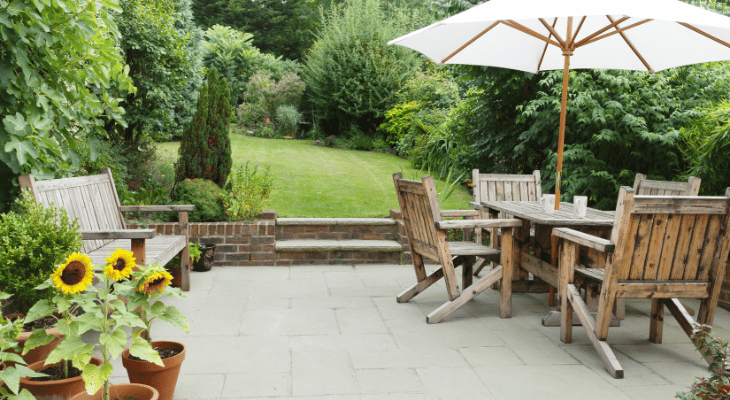
Your patio furniture is an investment in comfort and style
rather than just an outdoor item. Proper storage and upkeep are essential to
safeguarding that investment and guaranteeing your patio furniture stays in top
shape year after year. This thorough tutorial reviews the justifications for
bringing your patio furniture inside, the procedures involved, and some
important advice for keeping your Outside Furniture in top condition.
Many people are perplexed why outdoor furniture needs to be
brought indoors, especially if it is made to endure the outdoors. Despite being
made to withstand different weather conditions, high exposure to the elements
can still cause damage. Consider the following persuasive arguments for taking
your patio furniture inside:
SAVE YOUR FURNITURE, EXTEND ITS LIFESPAN
By keeping your patio furniture indoors while not in use or
during the off-season, you protect it from inclement weather, UV radiation, and
temperature changes. This protection may considerably increase your furniture`s
lifespan.
SIMPLIFY YOUR LIFE, LESSEN MAINTENANCE
Cleaning and maintenance are reduced when exposure to the
elements is less. Your furniture cleaning, refinishing, and repair efforts will
take less time and effort.
PREVENTS FADING, RUST AND CORROSION
Sunlight can cause cushions, textiles, and painted surfaces to fade and discolor. Your furniture`s rich colors and aesthetic are preserved when you bring it inside. Metal patio furniture made of steel or iron may rust when exposed to moisture over time. Corrosion and rust are avoided by storing it indoors.
FOCUS ON UPKEEP, REDUCE MOLD AND MILDEW
Due to humid and moist environments, fabric and cushion
covers can become infected with mold and mildew. Keeping your furniture in a
dry space will help you avoid these problems.
HOW TO INDOORLY STORE PATIO FURNITURE
Now that you are aware of the advantages of indoor storage
let`s examine how to keep your patio furniture secure indoors:
THOROUGHLY CLEAN
Clean your furniture well before bringing it inside. Clear the area of any outdoor use residue, dirt, dust, and leaves. If necessary, think about sanding and refinishing wooden furniture.
DISMANTLE
It`s a good idea to disassemble any modular or disassemble able furniture. With less chance of harm, storage becomes more
manageable.
REMOVE FABRIC COVERINGS AND CUSHIONS
Remove the fabric coverings and cushions from the chairs, sofas, and chaise lounges. They should be cleaned and washed by the manufacturer`s recommendations and stored somewhere dry. Locate a cool, dry spot to keep your patio furniture. 4. keep in a Dry Area. The best solutions are a garage, basement, or specific storage shed. Make sure there is enough airflow to stop moisture from accumulating.
CONSIDER USING FURNITURE COVERS
Consider using furniture covers to protect your goods from
dust and dirt while in storage. These covers are extremely useful for objects
that can`t be taken inside.
ELEVATE FURNITURE
To avoid contact with dampness, elevate your furniture
whenever possible. For this, you can use furniture risers or wooden pallets.
PROTECT AGAINST PESTS
Use pest repellents or traps in the storage room to keep
pests like rats and insects at bay. You can also cover your furniture with
tarps or blankets to create a barrier.
DON`T STACK HEAVY ITEMS
Heavy furniture items should not be stacked on top of one
another as this may cause warping or damage. Store them instead side by side or
with padding between them.
REGULARLY CHECK FOR DAMPNESS
Check your storage
room sometimes for leaks or other indications of moisture. As soon as a problem
arises, take care of it to protect your furnishings.
HOW TO HANDLE SPECIFIC MATERIALS?
When kept indoors, certain materials need to be handled with particular care. Here are some pointers specific to materials:
- Metal furniture should be cleaned with a damp cloth to remove dirt or moisture before being stored. A coat of auto wax can be applied to help protect the paintwork.
- It`s a good idea to occasionally check your
wooden furniture for pest damage or other issues. Add wood polish or oil to
keep it shiny and shield it from moisture.
- Keep wicker and rattan furniture inside to avoid exposure to humidity, which can lead to warping or mold formation. They need regular dusting.
- Plastic and resin furniture should be completely
cleaned and dried before storing, even though it requires little upkeep. To
keep it from fading, store it away from the sun.
WHEN YOU SHOULD BRING THE FURNITURE INDOORS?
Depending on your temperature, you can choose when to move
your Patio Furniture inside. The following are some general principles:
SEASONAL STORAGE
If your area has
distinct seasons, consider moving your patio furniture inside for the winter or
whenever it`s not in use. It is thus more shielded from severe weather.
EXTREME WEATHER EVENTS
If you expect extreme weather like hurricanes or torrential
downpours, move your furniture inside or cover it with sturdy covers.
WHENEVER IT IS NOT IN USE
Even in the summer, consider bringing your patio furniture inside when it won`t be used for an extended period. This lessens the damage caused by repeated exposure. Schedule recurring cleaning and maintenance appointments for your outdoor furniture. Now is a great time to decide if it needs to be taken inside for longer-term storage.
FINAL WORDS
An intelligent and responsible way to safeguard your investment and maintain the longevity of your patio furniture is to store it properly indoors. You can enjoy lovely, well-maintained outdoor furniture year after year by following the instructions provided in this guide and consider BLUU to get your specific patio furniture`s. The beauty and practicality of your patio furniture may be preserved with a little care and attention, transforming your outdoor area into a welcoming and cozy retreat for leisure and enjoyment.



